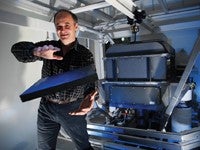Gravitational
quantum
states
are
traps
for
ultracold
massive
particles
with
gravity
on
top
and
a
specularly
reflecting
mirror
with
a
sharply
changing
surface
potential
on
bottom.
Energies
of
neutrons,
hydrogen
and
antihydrogen
atoms
in
gravitational
states
are
of
the
order
of
ε0~0.6peV,
and
the
characteristic
size
of
wave
functions
is
l0~5.9μm.
Ultralow
energies
make
this
system
very
sensitive
to
any
tiny
interactions,
and
large
sizes
simplify
the
experimental
techniques.
Gravitational
quantum
states
were
discovered
in
experiments
with
ultracold
neutrons
in
2002,
and
since
then
they
are
actively
used
by
several
research
groups
(qBounce,
Tokyo,
GRANIT)
at
ILL,
Grenoble.
While
repulsive
neutron-nuclei
optical
potential
of
many
materials
totally
reflect
ultracold
neutrons
from
surfaces,
attractive
van
der
Waals/Casimir-Polder
potentials
can
also
reflect
ultracold
atoms
and
molecules
at
surface
due
to
quantum
reflection.
In
contrast
to
the
case
of
neutrons,
nobody
has
ever
observed
gravitational
states
of
atoms
and
antiatoms.
Meantime,
major
motivations
are
growing
up
and
prompting
experimental
efforts
to
observe
gravitational
states
of
atoms
and
antiatoms,
and
to
improve
to
the
maximum
extend
the
precision
in
such
experiments.
Thus,
gravitational
states
of
antihydrogen
in
the
GBAR
project
at
CERN
is
the
most
precise
method
identified
so
far
for
the
direct
measurement
of
the
gravitational
acceleration
of
antimatter.
Gravitational
states
and
a
related
phenomenon
of
centrifugal
quantum
states
of
these
particles
is
a
sensitive
method
for
the
searches
for
extra
short-range
forces
arising
due
to
yet
undiscovered
light
bosons
or
other
phenomena
beyond
the
Standard
Model,
manifestations
of
extra
dimensions
or
dark
matter.
The
techniques
developed
within
these
studies
promise
to
help
achieving
ultralow
energies
of
atoms
thus
providing
unprecedented
conditions
for
optical
and
hyperfine
spectroscopy
of
with
ultimate
precision,
which
will
be
pursuit
within
the
GRASIAN
project.
[V.V.
Nesvizhevsky,
A.Yu.
Voronin,
Surprising
Quantum
Bounces,
Imperial
College
Press,
London,
2015]
 Valery
Nesvizhevsky
Valery
Nesvizhevsky